Research Division
Reprinted from "INSULATORS - Crown Jewels of the Wire",, November 1970, page 14
From David Fredrickson:
I have dug, found or traded the following
insulators (shown in sketch below), but am not sure just what I have. The
first, I think is a lightning rod insulator, but would like to find out more
about them, who made them, the value, age, etc.
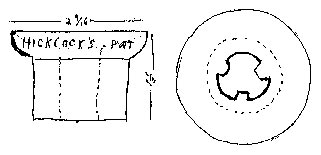 Color
green; embossed HICKCOCK'S PATENT 1859 Color
green; embossed HICKCOCK'S PATENT 1859
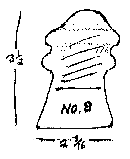 Color aqua; threaded, seam stops at second roll, embossed NO. 9
Color aqua; threaded, seam stops at second roll, embossed NO. 9
Doug Parks of Ogallala,
Nebraska write:
Insulator used on the first
transcontinental, St. Joseph, MO to Sacramento, Calif. and erected in 1862
by
Edward Creighton for the Western Union Telegraph Company. This insulator
was found by
F. R. Dovenspike in the vicinity of Old Fort Laramie in 1916 and loaned for
display
in the Scottsbluff National Monument Museum (1936) and after 78 years is back at
Old Fort Laramie, Wyoming, 1940.
Signed: Mrs. Kent, Owner
This is the note that was put in the insulator, as
best I can determine, in 1936. By looking at the original it looks like the phrase "and
after. . . 11 was added in 1940 and the "Mrs. Kent, Owner" at still a later date. The
insulator was sold at Mrs. Kent's estate sale in Holyoke, Colorado, and this is where I
bought it in 1968. The insulator is the center one with the wooden cover - a Wade.
The other two are also Wades, the one with the bumps being the same as the one with
wood cover, and the other a very rare variety with concave sides and a large button
type mold on top. This one still has a big chunk of molten sulphur in the pin hole.
These two we dug up from old fort sites on the Oregon Trail.
 The Kent specimen evidently was loaned to the Scotts Bluff National
Monument Museum in Nebraska, in 1936, and then taken to Ft. Laramie Museum, in Wyoming, in
1940, and then later removed from that museum and kept at home (Kent's). The Kent specimen evidently was loaned to the Scotts Bluff National
Monument Museum in Nebraska, in 1936, and then taken to Ft. Laramie Museum, in Wyoming, in
1940, and then later removed from that museum and kept at home (Kent's).
I'm quite proud of this item, and it enjoys the prime spot on my wall. It is, I'm sure,
especially with the wooden cover, super double rare. The missing piece of wood has rotted
out - I'm sure this is where it lay on the ground from ? to 1916.
From Hugh Summers:
I enjoyed your report on the first National Insulator Meet, and the pictures were very good; but
there is one thing that leaves me all agog. It is the case of the mint glass blocks found in an old
warehouse with a price range of $750. 00 each. For goodness sakes, what are
these, and can we have some more information on them, with possibly a picture?
There is also an ad in the September 29 issue of "The Antique Trader" that
lists a green unembossed 1846 block glass, also known as tree insulator, bird house and coffin insulator, price
$825.00.
After receiving your letter, I tried to take some pictures of Don's glass block insulator, but as a photographer I'm not so good, plus I don't have the
right equipment, but maybe these will help you.



Top view of glass block insulator
Looking through the slot; side of block
These are old and crude blocks of green glass. (They also were made in aqua, and
we have heard of one in amber.) We understand these were used around 1847. Here is what information we
have.
An early type took the form of a glass block with a double-tapered, slotted hole for
the wire. The entrance to the slot was zigzagged so the wire wouldn't slip out. These insulators had flanges on the ends and were sometimes set in wooden
blocks nailed to the side of a pole or tree, or in an iron frame; or even on the
top of the pole with a small wood roof to shed rain.
We understand that Don's glass block came out of an old railroad station attic built
in 1853 or 1854. I hope this has enlightened you somewhat concerning the glass block insulators.
Below is a sketch taken from "The
Collectors' Guide for Glass Insulators Book 2" by Cranfill and
Kareofelas. (The Glass Block)
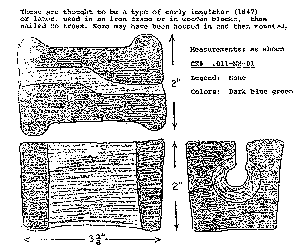
From Doug Stapp:
I recently acquired an S. McKee & Co. unthreaded insulator, and while researching that company turned
up some information which might be of interest to fellow collectors. S. McKee (or S.
M'Kee) & Co. also manufactured violin scroll flasks, and this fact may already be
known by some of the people who also collect bottles, but the interesting information is the record of another violin scroll flash manufacturer: R.
Knowles & Co. Union Factory, South Wheeling, Virginia. A question could be posed at
this point: Did this company in fact manufacture the Knowles insulators ? If so,
two flaws appear in this theory: 1) What is the tie-in with Mayer & Englund of
Philadelphia? and 2) What of the Knowles insulators with the Hemingray name still discernible? Time and information from other readers will either
prove or disprove this theory.
From William Hill:
Enclosed is a sketch and description of an
insulator. I want to know if anyone else has heard of this type of insulator,
and if someone else has, could they tell me how old it is and what company made
it? This insulator was found just should of Phoenix, Arizona, at a place
called Maricopa.
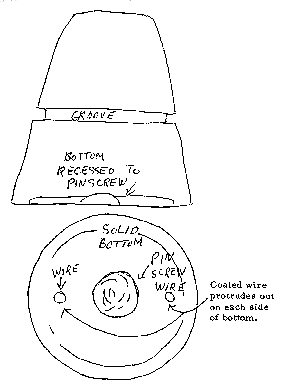 This is a
signal about the size of a Hemingray 42. It is an unglazed clay, gray in
color, and looks like stone. There is no inside or outside skirt.
The bottom is solid to pinhole except for small wire outlets. This is a
signal about the size of a Hemingray 42. It is an unglazed clay, gray in
color, and looks like stone. There is no inside or outside skirt.
The bottom is solid to pinhole except for small wire outlets.
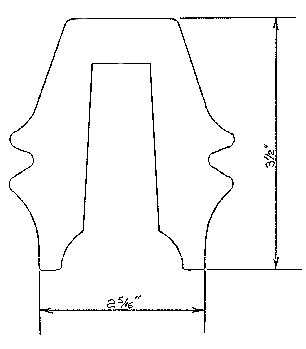
Dennis Donovan
wrote to say he bought this different sytle threadless at a flea market for
$30.00 How lucky! Does anyone else have one? This is new to me. -- Editor
From Robert Tucker: He is a drawing
of an insulator that you might be interested in. It was picked up by my
brother this summer in Colorado.
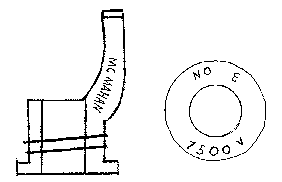
It is clear in color and 2 5/8" high and 1
3/4" across. It is faintly embossed Mc MAHAN on the side of the
arm. Around the base rim is 7500 V and NO. E (backwards "3").
Its is threaded around the outside.
My brother said that there were 5 others like it
in the window of the antique show where he bought it. The man who sold it
to him said that a cousin of his had picked it and 5 others up in Germany
several years ago.
If possible, I would like to know its age and its
use.
James Branstetter writes:
We have found what we think is a rare insulator.
We would like to find out more about it. It is the H.G.Co. petticoat, CD
162, no drip points, no patent date, cobalt. Have you seen this one?
We found two - have one in our collection, have one for trade. All we know
of.
| 